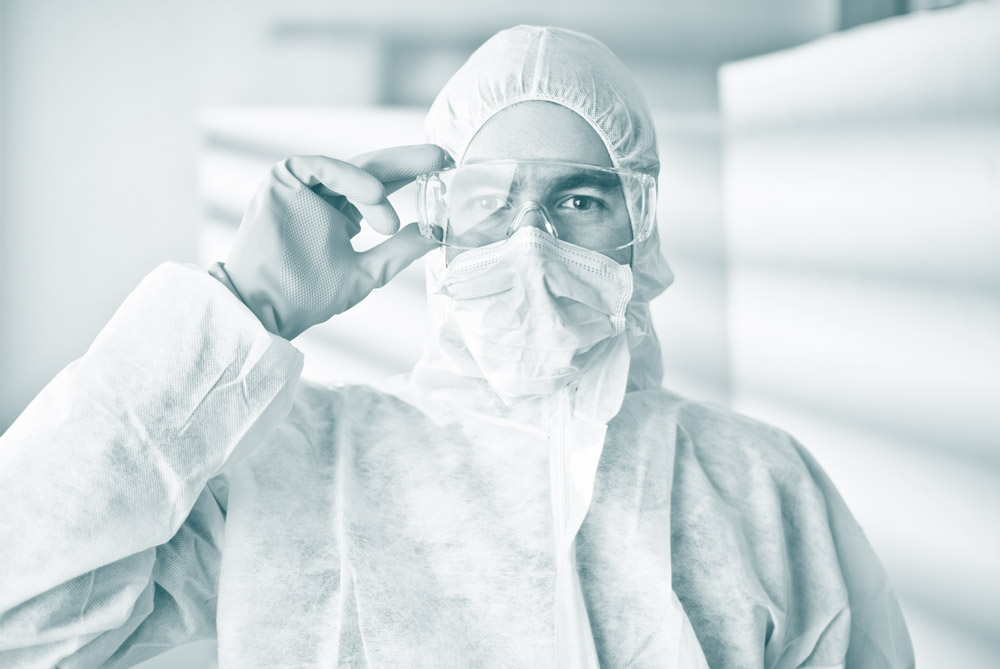Technical Brief
TECHNICAL BRIEF: Pre-Wetted Wipers
HOW ARE PRE-WETTED WIPERS OPTIMIZED FOR APPLICATION-SPECIFIC CLEANING?
This technical note will discuss the ideal concentrations of isopropyl alcohol (IPA) in pre-wetted wipers for different cleaning applications. We will also explain why pre-wetted wipers are designed with varying levels of wetting to optimize cleaning. This information will help you choose the right pre-wetted wiper for your specific cleaning needs.
Pre-wetted wipers are a popular choice for maintaining cleanliness in cleanrooms. They are a convenient delivery system that combines cleanroom wipers with the right amount of cleaning liquid for wiping down environmental surfaces, such as bench tops, counters, carts, trays, etc. Pre-wetted wipers are also helpful for cleaning process equipment and manufactured products. Choosing the correct pre-wetted wiper product for each cleaning task is crucial.
WHAT IS THE MOST WIDELY USED CLEANROOM CLEANING LIQUID?
A popular cleaning liquid used in pre-wetted wipers is isopropyl alcohol (IPA). This cleaning agent is widely available, is reasonably priced, and has excellent soil removal capability. The most important advantage of IPA is that it evaporates completely without leaving a surface residue. As a result, it is commonly considered the universal wetting agent for pre-wetted wiper products. Ensuring that the IPA used to wet the wipers meets the required specifications and testing standards is critical. For the electronic industry, this means that the IPA should have extremely low ion profiles, while for the healthcare industry, it means the absence of viable or non-viable organisms. Achieving this latter requirement involves sub-micron filtration of the IPA before wetting the wipers. It’s worth noting that filtration will not remove dissolved ions. Ideally, electronic-grade IPA (rated 99.5% pure or higher) should be used because it has the lowest level of contaminants.
WHAT IS THE OPTIMUM IPA CONCENTRATION FOR PREWETTED WIPERS?
A common question among cleanroom operators is what the ideal concentration of IPA in pre-wetted wipers is. Although countless IPA concentrations could be considered, we only need to focus on three concentrations, namely 6% IPA, 70% IPA, and 100% IPA, to fulfill most cleanroom cleaning requirements. The decision on which concentration to use depends on the nature of the manufactured products and the surface that requires cleaning.
WHAT IS THE MOST EFFECTIVE IPA CONCENTRATION FOR HEALTHCARE?
The healthcare industry includes pharmaceutical and biotechnology products and services, medical devices, pharmaceutical compounding laboratories, and animal care products. All these industries have a common requirement to keep their manufacturing and support areas free from contamination by microorganisms such as bacteria, viruses, and fungi. The most effective IPA concentration for sanitizing surfaces in the healthcare industry is 70%, which contains 30% deionized water (DIW). The water content of this solution allows it to penetrate the cell nucleus and kill the organism. However, it’s worth noting that 70% IPA solutions cannot kill spores, but other treatment methods are available to deal with them.
Another advantage of using the 70% IPA solution is that it reduces surface tension, making it easier to dissolve or remove soils and residues from surfaces. However, pre-wetted wipers incorporating 70% IPA are classified as flammable, which means they must be handled, transported, stored, used, and disposed of accordingly.
The wipers for cleanrooms outside of healthcare (e.g., microelectronics, aerospace, flat panel displays, hard drives) may use 6% or 100% IPA solutions.
WHY USE A LOW IPA CONCENTRATION?
Wipers pre-wetted with a solution containing 6% IPA are commonly used for wiping down environmental surfaces (as mentioned above). These surfaces are typically cleaned on a daily or shift basis, so significant contamination levels are unlikely to have accumulated since the last cleaning. Therefore, wipers pre-wetted with 6% IPA are sufficient for removing surface particulate matter and capturing it into the wiper.
The 6% IPA concentration works as a bacteriostat, inhibiting mold growth in the product. Additionally, this concentration is well below the 10% IPA limit, which would require the pre-wetted product to be classified as flammable. Thus, a 6% IPA concentration allows the product to be classified as combustible, making storage and disposal more manageable and less expensive. The 6% IPA solution somewhat reduces surface tension, but the wiping action is the primary mechanism for surface particle removal. Furthermore, using 6% IPA solutions minimizes Volatile Organic Compounds, which can benefit an organization’s environmental control department.
WHY USE A HIGH IPA CONCENTRATION?
Industries beyond healthcare have to clean more than just environmental surfaces. They also have to clean product surfaces or production surfaces that come into contact with the product. In these cases, it’s essential to remove soils or residues at regular intervals to avoid contamination of the end product. To achieve maximum cleaning power, pre-wetted wipers containing 100% IPA are ideal for such applications as they offer the highest surface tension reduction. The 100% IPA wetting liquid is advantageous as it has no water and is a drying agent if any water is present on the surface to be cleaned. This feature is critical in the semiconductor industry, where specific vacuum process equipment must remain free of water (including water vapor) at all costs.
If soiled surfaces need to be cleaned and water can be tolerated, pre-wetted wipers with 70% IPA can be used.
WHAT ABOUT INTERMEDIATE CONCENTRATIONS OF IPA?
It may seem odd that intermediate concentrations of IPA, such as 9%, 40%, or 85%, are not commonly used as wetting solutions. However, it would be best to balance multiple factors simultaneously, including cleaning power, flammability rating (as shown in the chart above), and Volatile Organic Compounds (VOCs).
ARE VOC’S A CONCERN WITH ISOPROPYL ALCOHOL (IPA)?
Volatile Organic Compounds (VOCs) are a concern that needs attention. Isopropanol, commonly known as IPA, is a volatile substance that quickly evaporates. It contains organic carbon and is classified as a VOC by the Environmental Protection Agency (EPA). The EPA requires that users disclose the amount of VOCs released into the environment from IPA and other volatile solvents. The reason for concern is that these VOCs contribute to smog formation. The more IPA is used, the more VOCs are released. The graph below shows a direct correlation between the amount of IPA used and the level of VOCs released. Minimizing IPA concentration and reducing usage will significantly reduce overall VOC levels.
It is important to note that beyond 6% IPA, there is little improvement in cleaning capability. The increase to 9% IPA is not worth the 50% increase in VOCs. Keeping the IPA concentration below 10% is recommended to maintain its combustibility rating. Therefore, the 6% IPA product should be used to clean appropriate cleanroom surfaces.
Once the IPA concentration exceeds 10%, it enters the flammability range. In this case, maximizing the cleaning capability by using 70% IPA is recommended, provided that water can be tolerated. If water cannot be used, 100% IPA is recommended. It’s important to note that using high concentrations of IPA significantly increases the VOCs released, which is an essential factor to consider.
If the goal is to remove or kill microorganisms, it’s recommended to use 70% IPA. There is no added benefit of using a higher concentration of IPA, as it might even reduce killing power. On the other hand, 100% IPA should be used when maximum cleaning capability is needed, and water must be kept away from the wiped surfaces.
WHAT IS THE OPTIMUM WETTING LEVEL IN PRE-WETTED WIPERS?
Cleanroom wipers are designed to absorb a maximum amount of liquid, known as the saturation level or the absorbent capacity. If you’ve ever tried cleaning a soiled kitchen counter with a fully saturated wet cloth, you know that only a tiny amount of soil is picked up while most of it gets spread around. For effective cleaning, a damp cloth is the optimal choice.
However, the question is, what is the best dampness level or wetting level for cleanroom wiping? In other words, what percentage of the maximum amount of liquid is suitable for cleaning? Typically, wetting levels of 45-50% of saturation work best for particle removal. This provides enough liquid to wet the surface and aid in particle removal but not so much liquid that it fills all the empty spaces in the fabric and prevents particles or soils from occupying them. The small amount of liquid left on the wiped surface evaporates quickly due to the high airflow in most cleanrooms.
In some cases, higher wetting levels of 60% capacity or more may be required if the wiper is used to apply IPA cleaning liquid to a surface or when you need to leave some IPA on the surface to maximize the destruction of microorganisms. Moreover, some soils may require more cleaning liquid to be removed from certain surfaces.
CONCLUSION:
For effective cleaning of environmental and production surfaces, it’s important to understand the ideal concentrations of isopropyl alcohol (IPA) and the corresponding wetting levels required in pre-wetted wiper products. This knowledge will help you select the appropriate pre-wetted wiper that meets your specific cleaning requirements.





















HAVE AN IDEA FOR CONTENT?
We are always looking for ideas and topics to write about.
Contact Us